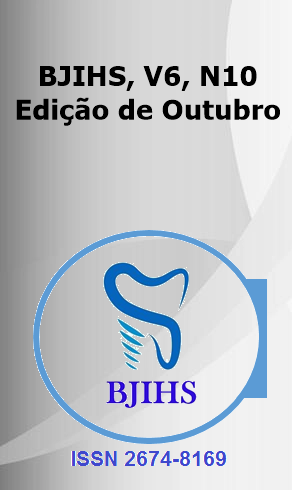Abstract
Introduction: Cerebrospinal fluid (CSF) otorrhea is a serious sign in the context of head trauma. If any ear discharge is noted after serious head trauma, particularly clear or bloody discharge, the patient should undergo evaluation for CSF otorrhea caused by a basilar temporal skull fracture. Objectives: discuss the evaluation of otorrhea in children. Methodology: Integrative literature review based on scientific databases from Scielo, PubMed and VHL, from January to April 2024, with the descriptors "Otorrhea", "Assessment" AND "Children". Articles from 2019-2024 (total 9) were included, excluding other criteria and choosing 5 full articles. Results and Discussion: Otorrhea means drainage of fluid from the ear. Otorrhea results from pathology of the external auditory canal or middle ear disease with perforation of the tympanic membrane. History and physical examination will differentiate between most causes of otorrhea in children. The evaluation of otorrhea in children is carried out by a doctor, which may include: checking vital signs and fever, inspection of the ear and adjacent regions to check for edema and hyperemia, palpation of the pinna and tragus to check for worsening pain, examination of the ear canal with an otoscope to check for secretion, lesions in the canal, granulation tissue and foreign bodies, examination of the tympanic membrane to check for inflammation, perforation, distortion and signs of cholesteatoma. Most children with otorrhea have bacterial otitis externa or acute otitis media (AOM) with perforation of the tympanic membrane. Patients who appear ill or have otorrhea following head trauma require aggressive efforts to diagnose and treat potential life-threatening causes of otorrhea (skull base fracture, necrotizing otitis externa, infectious complications of AOM). Once a working diagnosis is established, rapid consultation with a pediatric ear, nose, and throat specialist is warranted for life-threatening conditions (e.g., cerebrospinal fluid [CSF] otorrhea], mastoiditis, or other infectious complications of AOM , necrotizing otitis externa or neoplasia) and those that require biopsy for definitive diagnosis. Treatment of otorrhea may include: Expectant management, with observation for 48 to 72 hours and use of symptomatic medications, application of medicine directly into the ear canal to dissolve the secretion and administration of antibiotics, if otorrhea is caused by a bacterial infection. Conclusion: Otorrhea is the discharge of secretion from the ear, which can be bloody, sero-mucous or purulent. According to the recommendations of the American Academy of Pediatrics, you should always start in children under 6 months, in the presence of otorrhea on examination, temperature above 39ºC, signs of toxemia or otalgia persistent for more than 48 hours.
References
Ghanem T, Rasamny JK, Park SS. Repensando o trauma auricular. Laryngoscope 2005; 115:1251.
Kansu L, Yilmaz I. Herpes zoster oticus (síndrome de Ramsay Hunt) em crianças: relato de caso e revisão de literatura. Int J Pediatr Otorhinolaryngol 2012; 76:772.
Rosenfeld RM, Schwartz SR, Cannon CR, et al. Diretriz de prática clínica: otite externa aguda. Otolaryngol Head Neck Surg 2014; 150:S1.
Rubin J, Yu VL, Stool SE. Otite externa maligna em crianças. J Pediatr 1988; 113:965.
Lieberthal AS, Carroll AE, Chonmaitree T, et al. O diagnóstico e o tratamento da otite média aguda. Pediatrics 2013; 131:e964.
Mattos JL, Colman KL, Casselbrant ML, Chi DH. Complicações intratemporais e intracranianas de otite média aguda em uma população pediátrica. Int J Pediatr Otorhinolaryngol 2014; 78:2161.
Wu JF, Jin Z, Yang JM, et al. Complicações extracranianas e intracranianas da otite média: 22 anos de experiência clínica e análise. Acta Otolaryngol 2012; 132:261.
Zapalac JS, Billings KR, Schwade ND, Roland PS. Complicações supurativas da otite média aguda na era da resistência aos antibióticos. Arch Otolaryngol Head Neck Surg 2002; 128:660.
Hurtado TR, Zeger WG. Hemotímpanos secundários à epistaxe espontânea em uma criança de 7 anos. J Emerg Med 2004; 26:61.
Conover K. Dor de ouvido. Emerg Med Clin North Am 2013; 31:413.
Macfadyen CA, Acuin JM, Gamble C. Antibióticos sistêmicos versus tratamentos tópicos para ouvidos com secreção crônica e perfurações de tímpano subjacentes. Cochrane Database Syst Rev 2006; :CD005608.
Sanna M, Russo A, DeDonto G. Atlas colorido de otoscopia, Thieme, Nova York 1999.
Gliklich RE, Cunningham MJ, Eavey RD. A causa de pólipos aurais em crianças. Arch Otolaryngol Head Neck Surg 1993; 119:669.
Magliocca KR, Vivas EX, Griffith CC. Lesões idiopáticas, infecciosas e reativas do ouvido e osso temporal. Head Neck Pathol 2018; 12:328.
Harris KC, Conley SF, Kerschner JE. Granuloma de corpo estranho do canal auditivo externo. Pediatrics 2004; 113:e371.
Persaud RA, Hajioff D, Thevasagayam MS, et al. Ceratose obturante e colesteatoma do canal auditivo externo: como e por que devemos distinguir entre essas condições. Clin Otolaryngol Allied Sci 2004; 29:577.
Shire JR, Donegan JO. Colesteatoma do canal auditivo externo e ceratose obturante. Am J Otol 1986; 7:361.
Rao AK, Merenda DM, Wetmore SJ. Diagnóstico e tratamento de otorreia espontânea do líquido cefalorraquidiano. Otol Neurotol 2005; 26:1171.
Hannley MT, Denneny JC 3rd, Holzer SS. Uso de antibióticos ototópicos no tratamento de 3 doenças comuns do ouvido. Otolaryngol Head Neck Surg 2000; 122:934.

This work is licensed under a Creative Commons Attribution 4.0 International License.
Copyright (c) 2024 Ana Clara Abrahão Melo, Maria Luiza Cardoso Ferreira Soares, Maria Eugênia Costa Casagrande, Maria Vitória Bugallo Toth
